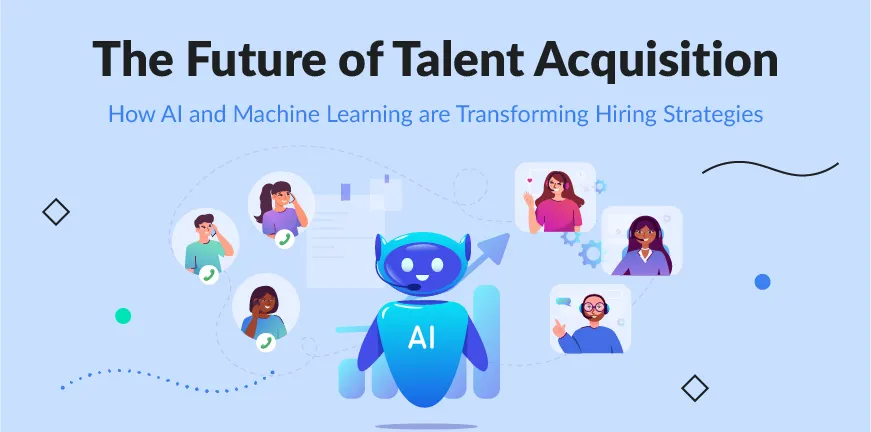
8 Key Leadership Principles for Managers to Excel in the Workplace
13/10/2025
What is Employee Empowerment? Definition, Benefits
24/10/2025Jack Welch, Former CEO of General Electric, has said, “Hiring the right people takes time, the right questions, and a healthy dose of curiosity.”
In an era where the job market has become a centre of the rat race, recruiting appropriate and skilled professionals is an intelligent decision that companies and recruiters need to make. But how would you be certain that your recruitment processes are effective? This is where you welcome KPI’s or Key Performance Indicators. These benchmarks are not mere numbers; they narrate the actual story about the entire talent acquisition process. Understanding the KPIs correctly and capitalizing on them will enable HR teams to build robust manpower.
What are the 15 Key Talent Acquisition KPIs to Track?
Hiring managers use recruitment KPIs to assess, calculate, and measure the performance of a hiring process. The data provided by the KPIs helps HR teams analyse issues and work on areas that require improvement. Let us have a look at some of the significant KPIs:
1. Time to Hire
These metrics are essential, and according to reports, 60% of recruiters rate them among their top metrics in India. It is typically the time taken by recruiters to hire suitable professionals in the hiring cycle. It is the duration that is calculated from the time a recruiter or hiring manager opens a job position, reaches out to the candidate, till the candidate accepts the job offer. The purpose of these metrics is to decipher the time of recruitment and how the time can be reduced by using various technologies and modern methods.
2. Time to Fill
The overall time taken to hire a candidate and place them in organizations is measured here. The calculation begins from the time a job has been posted. This helps in identifying the time and the reasons slowing down the recruitment process. This enables the recruitment teams of organizations to work on the reasons and expedite it, making the procedure cost-efficient, generating value.
3. Offer Acceptance Rate
This is the determinant of how quickly a candidate will accept the job offer. It is also one of the most important hiring KPIs, which will alert you if your offer acceptance rate is below the benchmark. If it is, then you must reanalyse your salary packages, time to hire, candidate experience, unsystematic offer process, etc. To improve these metrics, you as a company will have to streamline the offer process, ensuring transparent communication.
4. Quality of Hire
The quality of hire depends on the kind of professionals HR managers or recruiters are hiring. If the hire is bad, it can cost organizations a lot of money. This metric is used to determine how a new candidate is performing and contributing to the growth of the company. It also determines how the candidate will perform long-term, evaluating how fit they are culturally, and how well they cater to the company’s vision and objectives.
As per reports, this is becoming the top metric for many recruiters in India, and 72% of recruiters now say it is their most important success metric.
5. First-Year Attrition Rates
This measures the percentage of employees who leave an organization within a year of joining. This indicates how impactful the onboarding process, recruitment, and the early stages of employee experience are. There could be various reasons influencing early attrition, like recruiting inappropriate candidates who don’t match the role or company values, ineffective onboarding, a dearth of career progress, etc.
6. Hiring Manager Satisfaction
As the name of the metric suggests, it measures the satisfaction levels of recruitment managers with the hiring process and the quality of candidates selected. A high metric indicates that the recruitment process is efficient, trustworthy, with sturdy collaborations and communication systems resulting in quality hires, improved retention rates, and overall success.
7. Cost Per Hire
Cost per hire is essentially the amount of money an organization spends on recruiting new hires to fill job roles. It is calculated by dividing the total recruitment cost by the number of individuals hired in a particular period. The metric is particularly useful to measure the profitability of a hiring process. It offers valuable information and statistics that help in structuring and implementing budget plans.
8. Effectiveness of Sourcing Channels
This metric is utilized to measure the performance of an agency or any channel that has sourced candidates. It calculates the total number of quality candidates that are sourced from any channel or agency, determining the channel’s effectiveness and the lowest cost at which candidates are sourced.
9. Agency Utilization Rates
This metric refers to the amount of time an employee or team focuses on yielding profits, devoting time towards client-oriented jobs, against their total working hours. This ensures how effectively an agency can make a profit by covering costs and how well the resources of the agency are being used.
10. Applicant Conversion Rate
This metric indicates how quickly a candidate successfully moves upwards from one phase of recruitment to another, finally getting recruited. It is proof of how well a recruitment cycle is performing and of effectively hiring individuals swiftly. Pursuing the rates of conversion will enable recruiters to comprehend and point out the exact stages where candidates drop out.
11. Candidate Satisfaction Level
This metric measures the satisfaction and happiness level of a candidate during the hiring process. Their happiness quotient can be gauged by surveys and other techniques. A solid candidate satisfaction score reflects on the company’s brand and enhances its image, drawing skilled and better talent. The recruitment process can also be improved once feedback from candidates is acquired.
12. Interview to Offer Ratio
This is an interesting aspect that measures the number of offers presented to candidates versus the total number of individuals interviewed. In this case, a low ratio indicates that the process is super-efficient and only well-skilled candidates have been interviewed. There are various factors influencing the ratio, like geographical location, types of industry, interview framework, etc.
13. Application Abandonment Rate
This is the rate that indicates the percentage of candidates or individuals who begin the recruitment process but leave it midway. The rate is calculated by dividing the number of users who left the process incomplete by the number of users who started it.
14. Candidate Hiring Velocity
This metric refers to the pace at which candidates pass through each stage of recruitment. This allows businesses to identify the issues lacking in a recruitment cycle. This is another one of the very vital recruitment success metrics. It measures how swiftly candidates are moving from one stage to another, points out the defects, and what is slowing down the process, etc.
15. Diversity of Hired Candidates
This metric is of grave importance in today’s scenario and refers to how a company or recruiters plan hiring strategies to include professionals belonging to diverse backgrounds, ages, experiences, etc. The hiring procedure involves an unbiased approach where, along with merit, niche talent is also considered and drawn from a wide talent pool.
Why do KPIs Matter in Talent Acquisition?
KPIs are integral to recruitment processes as they power organizations and hiring teams by providing powerful and valuable information that impacts the efficiency and overall progress of a hiring system. The key hiring indicators can recognize the loopholes in the hiring cycle. The approach is tech-enabled and data-powered, enhancing strategies, diminishing expenses, accelerating candidate experience, and driving organizational success. They cater to business goals by drawing, aligning, and retaining the right talent.
How to Track and Measure KPIs Effectively?
Here are a few important methods to track Hr performance metrics. Let us check them out:
Highlight relevant Objectives
As a recruiter or company, your first step is to design and set goals that cater to your requirements. You have to be clear about which metrics you want to track.
Choose intelligent KPIs
It is of utmost importance that you select the most effective metrics without disrupting your team’s peace.
Utilize correct tech and tools
You must capitalize on AI-driven technologies and systems to track KPIs, making processes fast and accurate.
Monitor and assess KPIs regularly
KPIs must be checked and overseen cautiously and daily, enabling the detection of early flaws before dampening the hiring process.
Working interdepartmentally
You must include the opinions and suggestions of individuals across departments in facilitating the KPI process.
What are the Key trends of Talent Acquisition KPIs?
Here are certain emerging trends in talent acquisition KPIs:
Switch from quality to quantity
Companies are now focusing on the long-term effects and performances of newly hired employees instead of prioritizing how quickly vacancies are filled.
Adoption of AI and People Analytics
Recruitment teams are utilizing and integrating AI-powered systems and platforms along with predictive analysis methods to anticipate performance and process progress.
Focus on Candidate Experience
In today’s day and age, how a candidate feels and how they gauge the entire recruitment journey matters a lot. This metric is being prioritised to the optimum.
DEI Oriented Hiring
Inclusivity and diversity in recruitment is the new norm, and organizations are formulating their talent strategy by including candidates from across regions, caste, sex, religion, etc.
Key Takeaways
- India rules in the Quality for Hire KPI
- Time-oriented metrics are still significant
- Candidate Experience is critical
- The future of KPI is tech-driven
- DEI is surfacing as a Priority
Frequently Asked Questions
1. What are KPIs in talent acquisition?
KPIs in recruitment cycles are metrics that measure the effectiveness and efficiency of a hiring process.
2. What are the most important talent acquisition KPIs?
The most important hiring KPIs include Quality of Hire, Candidate Experience, Cost per Hire, Time to Fill, Offer Acceptance Rate, and Sourcing Channel Effectiveness.
3. Which KPI measures recruitment effectiveness?
KPIs measuring recruitment effectiveness entail Time to Hire, Cost-per-Hire, Quality of Hire, Offer Acceptance Rate, Candidate Experience, Source of Hire, and New Hire Turnover Rate.
4. What is the difference between recruitment metrics and KPIs?
Recruitment metrics are broad data points used to measure various facets of hiring, while KPIs are measurements that are specific to working towards long-term goals.
5. What are the top 5 recruitment KPIs HR should track?
The top 5 KPIs that must be tracked by HR are Time to Fill, Cost per Hire, Quality of Hire, Source of Hire, and Offer Acceptance Rate.
6. What is a good time-to-hire KPI?
The time to hire KPI varies from industry to industry and the roles that are being hired for.
7. How can companies measure the quality of hire?
Organizations measure the quality of hire by blending metrics like time to productivity, performance review scores, retention rates, employee engagement, etc.
8. What are examples of talent acquisition metrics for diversity?
Talent acquisition metrics include tracking the diversity of talent pools, diversity of new employees, offer acceptance rates by demographic, retention rates by demographic group, and diversity in leadership positions.

Neelakantayya Hiremath
Neelakantayya Hiremath serves as the Operations Head – Talent Acquisition at Alp Consulting Ltd., with over 18 years of extensive experience in recruitment operations, workforce strategy, and leadership hiring across technical and non-technical domains. He has successfully led large-scale talent acquisition programs across infrastructure, energy, BFSI, and technology sectors. With deep expertise in RPO delivery, client engagement, and strategic hiring, Neelakantayya drives efficient, business-aligned recruitment solutions that adapt to evolving industry dynamics and organizational goals.




